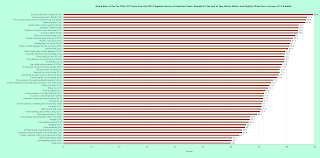An interesting article by Rob Gabriele at SafeHome.org on October 25, 2023 is titled What Americans Fear Most: 2023 Fear Ranking. It describes results from a survey of 2,634 U.S. adults.
His description in the overview explains:
“To understand which concerns fuel America's anxiety, we asked participants to disclose how much they fear 72 unique situations across several general categories. After adjusting results to ensure an accurate representation of the population, we calculated ‘fear scores’ to quantify the collective fear associated with each subject. Scenarios with higher scores (closer to 100) indicate more people were afraid, and situations scores closer to zero were less frightening for our respondents.”
And the second paragraph under Our Data and Complete Fear Rankings elaborates:
“Fears were ranked by two metrics: The percentage of respondents who were afraid or very afraid of each scenario, and by a fear score. The fear score is a normalized weighted sum whereby ‘Very afraid’ was weighted 3, ‘Afraid’ was weighted 2, ‘Slightly afraid’ was weighted 1, and ‘Not afraid’ was weighted at 0. The number of responses for each is multiplied by their weight and summed together, then normalized by dividing by two times the total number of responses, then multiplied by 100 and rounded to the nearest integer.”
The Fear Score describes How Much?, while the percent Afraid or Very Afraid describes How Many? But his scaling for the Fear Scores is peculiar. One way to state it is on the scale from 0 to 3 described above. Back on October 30, 2015 I blogged about calculating fear scores in a post titled According to the 2015 Chapman Survey of American Fears adults are less than Afraid of federal government Corruption and only Slightly Afraid of Public Speaking.
A second way is to divide that number by three (a Corrected Fear Score), so it is a proportion (or multiply by a hundred to make it a percent). Instead he divided by two, which for these particular results fortuitously made the highest score 99 (almost 100).
The second paragraph of the article is titled Americans’ Top 10 Fears, 2023 and he just provides a list of the scenarios without either the Fear Scores or the percent Afraid or Very Afraid. As shown above, I have provided a table with both sets of percentages - which are surprisingly close to each other.
That similarity carries over to all 72 of the percentages
for Very Afraid plus Afraid, as is shown in a pair of bar charts for the Top
Forty and Bottom Thirty-Two fears. The corrected fear score is shown by the digits
at the right in the caption for each scenario. Based on its corrected fear score of 41 public speaking ranks 28 of 72 fears at 41%.
I was irritated that Mr. Gabriele did not bother to discuss the nine Chapman Surveys of American Fears, or compare his results with theirs. His questions are a smaller set similar to those in that set of surveys which began back in 2014.
He did a similar survey of 41 fears in 2021, which is discussed in another article titled America’s Top 10 Fears: The 2021 American Fear Index. I had not discussed that one previously in this blog, since it did not include the fear of public speaking. As shown above in another table with both sets of percentages, the Top Ten there for Fear Scores and the percent Afraid or Very Afraid also are surprisingly close to each other.
The US flag fear frowny was adapted from this smiley at Openclipart.




















































